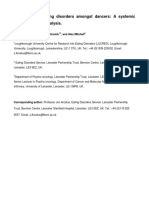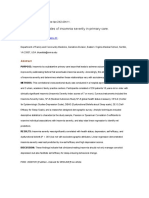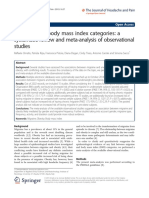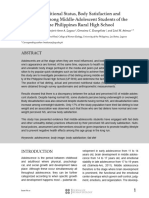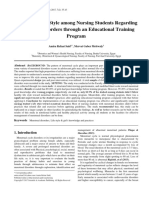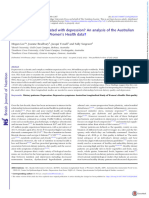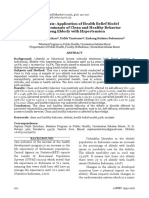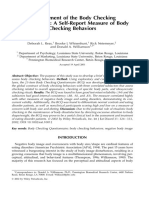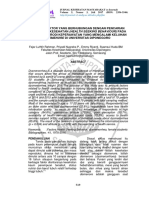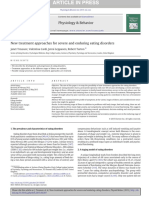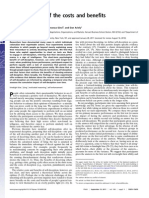NIH Public Access: Author Manuscript
NIH Public Access: Author Manuscript
Uploaded by
Anca RaduCopyright:
Available Formats
NIH Public Access: Author Manuscript
NIH Public Access: Author Manuscript
Uploaded by
Anca RaduOriginal Description:
Original Title
Copyright
Available Formats
Share this document
Did you find this document useful?
Is this content inappropriate?
Copyright:
Available Formats
NIH Public Access: Author Manuscript
NIH Public Access: Author Manuscript
Uploaded by
Anca RaduCopyright:
Available Formats
NIH Public Access
Author Manuscript
Eat Weight Disord. Author manuscript; available in PMC 2012 February 2.
Published in final edited form as: Eat Weight Disord. 2011 September ; 16(3): e199e203.
NIH-PA Author Manuscript NIH-PA Author Manuscript NIH-PA Author Manuscript
Selective Processing of Body Image Words in Women At-Risk for Developing an Eating Disorder: A Preliminary Study
Vandana A. Aspen1, Richard I. Stein1, Jordana Cooperberg1, Jamie L. Manwaring1, Deanna Barch2, and Denise E. Wilfley1 1Washington University School of Medicine, St. Louis MO
2Washington
University, Department of Psychology, St. Louis, MO
Abstract
We evaluated the utility of the Modified Stroop task as a measure of body image concerns in women at-risk for an eating disorder. Data were collected among 31 participants from an eating disorder prevention program. The Modified Stroop was significantly associated with overeating episodes and an explicit measure of shape concern. The traditional Stroop effect was found while the Modified Stroop effect was non-significant. The results raise questions about the Modified Stroop task's utility in identifying at-risk women. Methodological and clinical implications are discussed.
Keywords Implicit Measure; Eating Disorder; Stroop Effect; Body Image; Cognitive Processing
Introduction
Disordered eating is widespread on college campuses, with studies reporting 19-25% of freshman women at-risk for developing an eating disorder (ED; [1-3]. In recent years, a number of longitudinal studies have identified body image concerns (i.e., weight and shape concerns) as a significant risk factor for the development of a subclinical and/or clinical ED [4-6]. To avoid the well-known medical, social and psychological comorbidities associated with EDs [7], it is of great importance to correctly identify the at-risk population so they can be given an effective prevention program. Most researchers have relied exclusively on explicit measures (i.e., self-report questionnaires and/or interviews) to assess body image concerns, along with other ED attitudes and behaviors. Although many of these instruments appear to be both reliable and valid, they may be limited by biasing factors such as demand characteristics, denial, social desirability, shame and/or embarrassment all of which are highly prevalent among women exhibiting ED symptomatology [8]. Also, by definition, explicit measures assess constructs
Corresponding Author: Vandana Aspen, Ph.D. Stanford University School of Medicine Department of Psychiatry 401 Quarry Road Stanford, California 94304. Institution where work was completed: Department of Psychiatry Washington University School of Medicine 4570 Children's Place St. Louis, MO 63110. Portions of these data were presented at the Association for Psychological Science annual conference, Washington DC, in May, 2007. The Weight Concerns Scale (WCS; [38] was used to determine high-risk eligibility [using a criterion score of >50 [39, 40]; scores range from 0-100]. The WCS has good predictive validity and has a test-retest reliability of .85 [5, 21]. This measure was chosen because it assesses body image concerns and previous research has shown that it significantly predicts females greater risk of developing an ED [5, 21].
Aspen et al.
Page 2
only at the level of conscious awareness. In contrast, implicit measures purport to assess unconscious thoughts and processes that are difficult to access using traditional self-report questionnaires and interviews. Assessing cognitions implicitly is particularly germane for women at-risk for an ED (e.g., those restricting intake, engaging in occasional bingeing and/ or purging, and/or with cognitive distortions related to weight/shape), as they typically report feeling ashamed of their symptoms (which introduces potential under-reporting biases using explicit measures), and they describe frequent cognitive preoccupations with food, weight and body image -- areas that implicit measures aim to tap [8]. Thus, using both implicit and explicit instruments to measure body image concerns may lead to a more comprehensive assessment of this important risk factor, ideally resulting in more precise identification of at-risk women. Over the last two decades, several implicit measures, traditionally used in cognitive research, have been adapted for use with clinical populations. One such measure, the Stroop task [9], was modified in the 1980s and has been used to measure biases in selective attention across the spectrum of psychopathology [10], including EDs [11]. In the modified version of the Stroop task, participants reaction times (RTs) in naming the colors of emotionally salient words are compared with RTs in naming the colors of neutral words, with longer RTs suggesting that the emotional relevance of the word category is causing interference. Although no extant studies have evaluated the utility of the Modified Stroop task in a population identified as being at-risk for EDs, a few have amongst female dieters [12, 13], and numerous studies have been conducted on individuals diagnosed with EDs. Most of this research has been cross-sectional, with overall results demonstrating an informationprocessing interference effect (i.e., longer RTs for ED-salient stimuli as compared to neutral stimuli) in dieting and ED populations as compared to normal controls [11-17]. Furthermore, one study examining the Modified Stroop among women with varying levels of ED symptomatology (i.e., healthy controls, women with sub-clinical ED symptoms and women with a diagnosis of bulimia nervosa) found that as symptoms increase, so did the interference score[18]. Given the similarity of symptoms in those diagnosed with an ED and those at-risk for an ED [19], the presence of interference effects amongst dieters (a risk factor for EDs), and potential incremental relation between symptomatology and interference, we hypothesized that the Modified Stroop task would be a viable and sensitive instrument to assess body image concerns in at-risk women. In particular, the objective of the present study was to determine whether the Modified Stroop task could effectively measure body image concerns in women at-risk for an ED. To our knowledge, this is the first study to evaluate the Modified Stroop task paradigm in a sample of women at-risk for an ED.
NIH-PA Author Manuscript NIH-PA Author Manuscript NIH-PA Author Manuscript Methods
Participants
Study Design The data collected for this study were examined within the context of a large randomized, controlled intervention outcome trial (RCT) of Student Bodies, an EDs prevention program [20].
Participants in the RCT were 52 college-age women in the Saint Louis area with high body image concerns, placing them at-risk for developing an ED [4]. Of these, a subset of 31 women agreed to participate in the current study and completed the Modified Stroop task at baseline. Participants and non-participants did not significantly differ on any demographic
Eat Weight Disord. Author manuscript; available in PMC 2012 February 2.
Aspen et al.
Page 3
or baseline variables; the only exception was that those who participated in the current study reported more overeating episodes (p = .019).
NIH-PA Author Manuscript NIH-PA Author Manuscript NIH-PA Author Manuscript
Regarding race and ethnicity, 77% of participants in the current study identified themselves as Caucasian, 3% as African American, 3% as Filipino, 3% as Vietnamese, and 13% as multiethnic or other. The average age of participants was 20.2 years (SD = 1.6; range = 18.3-26.4), and average body mass index (BMI; weight in kg/height in meters2) was 23.8 (SD = 2.2; range = 19.9-28.5). The sample consisted of 35% freshmen, 25% sophomores, 22% juniors and 12% seniors. All participants in the larger RCT received $25.00 for participation; those completing the current Modified Stroop task study received an extra $10.00. This study was reviewed and approved by the Hilltop Human Studies Committee at Washington University. Measures The Weight Concerns Scale (WCS)[21] was used to determine risk status. The WCS consists of 5 questions that assess worry about weight and shape, fear of gaining 3 pounds, last time on a diet, importance of weight, and feelings of fatness. The WCS has test-retest reliability of .85 and good predictive validity [5, 21]. A receiver operating characteristic (ROC) analysis found that a WCS score of 47 or higher had a sensitivity of 79%, specificity of 67%, and positive predictive value of 13% for identifying individuals who developed partial- or full-syndrome EDs [22] In our study, women were considered at-risk if they scored 50 or higher on the WCS, reported they were moderately or very afraid of gaining 3 pounds, and or reported that their weight was the most important thing in their life. An abbreviated version of the Eating Disorder Examination (EDE; [23], which only included diagnostic items, was administered at baseline to determine study eligibility (i.e., ruling out potential participants with subclinical or clinical EDs) and to assess total purging and overeating episodes in the previous three months. The EDE, often considered the gold standard in assessing EDs [24], is a semi-structured interview that generates ED diagnoses based on DSM-IV criteria. Other explicit measures of eating attitudes and behaviors included the Eating Disorder Examination self-report questionnaire (EDE-Q; [25] and the Eating Disorder Inventory (EDI; [26]. The EDE-Q consists of four subscales -- Restraint, Eating Concern, Shape Concern and Weight Concern -- that have good psychometric properties and good internal consistency ranging from 0.78 to 0.93 [27]. The EDI consists of the Drive for Thinness (DT), Perfectionism (P), and Bulimia (BUL) subscales, which are widely used and have good internal consistency [26]. The Modified Stroop task was given pre-intervention. Participants were presented with words in yellow, red, blue, or green font. Body-related words were selected from word lists used in four previous studies [28-31] that evaluated the impact of body image words on Stroop performance. The word group categories and specific words were as follows: body words (belly, chubby, fat, flabby, hips, overweight, plump, shapely, slim, stomach, thighs, weighing), control (emotionally neutral) animal words (buffalo, cat, cows, duck, greyhounds, rabbit, rhinos, seagull, shedding, swans, tiger, walrus) matched with body words for frequency of usage and length [32], and the original Stroop color discrepancy task divided into congruent words (e.g., the word green written in green) and incongruent words (e.g., the word red written in blue, green, or yellow). All words were presented on a Macintosh 15-inch computer screen in an interleaved presentation. Both the order of the words and colors were randomized by the computer program. Words were shown in size 36point Helvetica font in the center of the screen. There were a total of 144 trials (4 sets of 36 trials), with each stimulus displayed on the screen for 2000 ms or until the participant responded. RTs were obtained through voice-activation, which recorded the time elapsed between stimulus onset and the participant's vocal response.
Eat Weight Disord. Author manuscript; available in PMC 2012 February 2.
Aspen et al.
Page 4
Procedure To avoid any priming effects, the questionnaires and Modified Stroop task were completed on different days; questionnaires were always completed prior to the Modified Stroop task. Instructions for the Modified Stroop task were to name the color of the words presented on the screen as quickly and as accurately as possible. Once the voice-activated button box was calibrated to the appropriate sensitivity, participants completed three practice trials, followed by the actual task. Statistical Analyses Modified Stroop data were analyzed using RTs as the dependent measure. Median RTs within each category for each participant were examined based on correct responses only. Error rates were not analyzed, as they were found to be infrequent and equivalent across word group categories [except color incongruent which, as expected, had more errors due to the basic Stroop interference phenomenon [9]]. Interference scores were calculated by subtracting the RTs for body words from RTs for control animal words; this score indicates the degree of delay caused by distraction from body-related words as compared with the neutral animal words. A similar interference score was calculated by subtracting RTs for the color congruent and color incongruent words, indicating the traditional Stroop effect. In addition, due to the low frequency of individuals reporting disordered eating behaviors, these variables were recoded into two corresponding variables dichotomized as the presence or absence of overeating episodes and purging episodes, respectively. Correlations were used to examine how interference scores related to conventional explicit body-image-related measures; t-tests were used to examine the relation between interference scores and disordered eating behaviors. Repeated measures analyses of variance (ANOVAs) were used to analyze the effect of word-type on participants RTs. Pre-specified contrasts/ post hoc tests were used to further examine any significant findings.
NIH-PA Author Manuscript NIH-PA Author Manuscript NIH-PA Author Manuscript
Results
Stroop Effects Correlational and t-test analyses found that body image interference scores were significantly related to scores on the EDE-Q shape concern subscale (r = .38, p = .03), EDE overeating episodes [t (29) = -2.0, p = .05], and correlated (at a trend level) with BMI (r = . 31, p = .09); all other correlations with explicit measures were non-significant (p >.10). Repeated measures ANOVA revealed a main effect for word type [F (3, 27) = 52.96, p < . 001], such that participants RTs varied depending on the word category (congruent, incongruent, body image, animal). Post-hoc paired t-tests conducted to further explore the main effect of word type confirmed that there were significant differences among all pairs of word types (all p <.001) except between body image and animal words, where the difference was non-significant (p > .10).
Discussion
The purpose of this preliminary study was to examine the utility of the Modified Stroop task as a measure of body image concerns in women at-risk for an ED. RT differences for the traditional Stroop effect were significant while those for the Modified Stroop effect were not. All participants took the longest amount of time to respond to color incongruent words from the traditional Stroop task, indicating that incongruent words caused the most interference -a predictable finding based on the Stroop phenomenon [9]. To address whether the Modified
Eat Weight Disord. Author manuscript; available in PMC 2012 February 2.
Aspen et al.
Page 5
Stroop task was an effective measure of body image concerns in at-risk women, we compared the RTs for the body image and animal words (post hoc paired t-test), with results revealing that this task did not capture significant interference. However, body image interference scores were significantly associated with the presence of overeating episodes and the Shape Concern subscale of the EDE-Q, a validated explicit measure of body image concerns. In addition, degree of interference also showed a positive correlation (at a trend level) with BMI, a reliable predictor of body image concerns in children [33] and young women [34]. The findings from this study raise questions about the potential utility of the Modified Stroop task in women at-risk for an ED. While we were able to show the traditional Stroop effect (which served as a methodological control), the findings from the Modified Stroop task were non-significant. The only positive findings were the associations of this task with a reliable predictor and a validated measure of body image concerns. One potential limitation that may have reduced these interference scores (difference between body image and animal words) may have been related to the selection of control words. In particular, although most of the animal words were unrelated to body image (e.g., rabbit, tiger), some words (e.g., cows, buffalo) may have inadvertently elicited body-related cognitions. Alternatively, the lack of findings may be due to the level of pathology in this population as opposed to a flaw in the methodology or the task itself. Body image concerns are often conceptualized on a continuum as opposed to dichotomy, with more severe concerns consistent with a diagnosable ED. Thus, perhaps the Modified Stroop task was not able to detect significant attentional bias because women at-risk for an ED are not as fixated on body-related information as are those with a full-syndrome ED -- a key feature that may distinguish these groups. Implicit measurement in clinical populations is a relatively new concept that may provide us with a more accurate assessment of symptomatology. It is important to note that the Modified Stroop task is merely one example of an implicit measure that can be modified for clinical use and, regardless of its utility in women at-risk for an ED, numerous other implicit measures may prove useful. Indeed, a recent review of the literature on cognitive processes revealed additional implicit measures that have been modified for ED populations. For example, the dot probe task [35] and the Implicit Associations Test (IAT; [36] have recently been recommended as valid implicit tests [15, 37], yet little empirical data exist on these modified measures. In addition, implicit measures with increased sensitivity may also be worth exploring. Thus, the next phase of research on implicit measurement in the at-risk ED population should be to determine whether any other implicit measures may better assess the body image construct. In conclusion, given the potential for bias (under-reporting) and high frequency of cognitive preoccupations in disordered eating populations, there seems to be a potential to use implicit measurement for assessment and/or identification purposes. The use of implicit measurement in at-risk women is still in its infancy, and further research on the Modified Stroop task and other potential implicit measures may assist in detecting women at-risk for an ED.
NIH-PA Author Manuscript NIH-PA Author Manuscript NIH-PA Author Manuscript
Acknowledgments
This study was supported by grants K24 MH070446 and R01 MH060453 awarded to Denise E. Wilfley from the National Institute of Mental Health, National Institutes of Health, as well as a faculty research development grant awarded to Denise E. Wilfley from the Department of Psychology at Washington University in St. Louis, Missouri. Vandana Aspen was partly supported by a NIH training fellowship (T32-MH19938) at Stanford University. Richard I. Stein was partly supported by a KL2 Career Development Award and the Clinical and Translational Science Award at Washington University School of Medicine (NIH grants KL2RR024994 and UL1RR024992).
Eat Weight Disord. Author manuscript; available in PMC 2012 February 2.
Aspen et al.
Page 6
References
1. Drewnowski A, et al. Eating pathology and DSM-III-R bulimia nervosa: A continuum of behavior. American Journal of Psychiatry. 1994; 151:12171219. [PubMed: 8037258] 2. Krahn DD, et al. Pathological dieting and alcohol use in college women -- a continuum of behaviors. Eating Behaviors. 2005; 6:4352. [PubMed: 15567110] 3. Kurth CL, et al. The severity of dieting and bingeing behaviors in college women: Interview validation of survey data. Journal of Psychiatric Research. 1995; 29(3):211225. [PubMed: 7473297] 4. Jacobi C, et al. Coming to terms with risk factors for eating disorders: Application of risk terminology and suggestions for a general taxonomy. Psychological Bulletin. 2004; 130(1):1965. [PubMed: 14717649] 5. Killen JD, et al. Weight concerns influence the development of eating disorders: A 4-year prospective study. Journal of Consulting and Clinical Psychology. 1996; 64:936940. [PubMed: 8916622] 6. Stice E. Risk and maintenance factors for eating pathology: A meta-analytic review. Psychological Bulletin. 2002; 128(5):825848. [PubMed: 12206196] 7. Brownell, K.; Fairburn, CG. Eating Disorders and Obesity. 2nd ed.. Guilford Press; New York: 2002. 8. Hermans D, Pieters G, Eelen P. Implicit and explicit memory for shape, body weight and foodrelated words in patients with anorexia nervosa and nondieting controls. Journal of Abnormal Psychology. 1998; 107(2):193202. [PubMed: 9604549] 9. Stroop JR. Studies of interference in serial verbal reactions. Journal of Experimental Psychology. 1935; 18:643662. 10. Williams MG, Mathews A, MacLeod C. The emotional Stroop task and psychopathology. Psychological Bulletin. 1996; 120(1):324. [PubMed: 8711015] 11. Dobson KS, Dozois DJA. Attentional biases in eating disorders: A meta-analytic review of Stroop performance. Clinical Psychology Review. 2002; 23:10011022. [PubMed: 14729421] 12. Elliman NA, Green MW, Wan WK. Gender differences in colour naming performance for gender specific body shape images. Eat Weight Disord. 1998; 3(1):1724. [PubMed: 11234250] 13. Pringle A, Harmer CJ, Cooper MJ. Investigating vulnerability to eating disorders: biases in emotional processing. Psychol Med. 2010; 40(4):64555. [PubMed: 19671208] 14. Johansson L, Ghaderi A, Andersson G. Stroop interference for food- and body-related words: A meta-analysis. Eating Behaviors. 2005; 6:271281. [PubMed: 15854873] 15. Lee M, Shafran R. Information processing biases in eating disorders. Clinical Psychology Review. 2004; 24:215238. [PubMed: 15081517] 16. Leonard T, et al. Selective processing of eating and body words in restricting-type anorexics, binge-eating-type anorexics, bulimics, and control subjects. Eat Weight Disord. 1997; 2(1):1723. [PubMed: 14655852] 17. Fassino S, et al. Attentional biases and frontal functioning in anorexia nervosa. Int J Eat Disord. 2002; 31(3):27483. [PubMed: 11920988] 18. Lokken KL, Marx HM, Ferraro FR. Severity of bulimic symptoms is the best predictor of interference on an emotional Stroop paradigm. Eat Weight Disord. 2006; 11(1):3844. [PubMed: 16801744] 19. Fitzgibbon M, Sanchez-Johnsen L, Martinovich Z. A test of the continuity perspective across bulimic and binge eating pathology. International Journal of Eating Disorders. 2003; 34:8397. [PubMed: 12772173] 20. Winzelberg AJ, et al. Effectiveness of an internet-based program for reducing risk factors for eating disorders. Journal of Consulting and Clinical Psychology. 2000; 68(2):346350. [PubMed: 10780136] 21. Killen JD, et al. Pursuit of thinness and onset of eating disorder symptoms in a community sample of adolescent girls: A three-year prospective analysis. International Journal of Eating Disorders. 1994; 16(3):227238. [PubMed: 7833956]
NIH-PA Author Manuscript NIH-PA Author Manuscript NIH-PA Author Manuscript
Eat Weight Disord. Author manuscript; available in PMC 2012 February 2.
Aspen et al.
Page 7
22. Jacobi C AL, Taylor CB. Screening for eating disorders and high risk behavior: caution. International Journal of Eating Disorders. 2004; 36:280295. [PubMed: 15478137] 23. Fairburn, CG.; Cooper, Z. The eating disorder examination. In: Fairburn, CG.; Wilson, GT., editors. Binge Eating: Nature, Assessment, and Treatment. 12th ed.. Guilford Press; New York: 1993. p. 317-360. 24. Wilson, TG. Assessment of binge eating, in Binge Eating: Nature, Assessment and Treatment. Wilson, CGFGT., editor. Guilford Press; New York: 1993. p. 227-249. 25. Fairburn CG, Beglin SJ. Assessment of eating disorders: Interview or self-report questionnaire? International Journal of Eating Disorders. 1994; 16(4):363370. [PubMed: 7866415] 26. Garner, DM.; Olmsted, MP. Eating Disorder Inventory Manual. Psychological Assessment Resources; New York: 1984. 27. Luce KH, Crowther JH. The reliability of the Eating Disorder Examination-Self-Report Questionnaire Version (EDE-Q). International Journal of Eating Disorders. 1999; 25:34951. [PubMed: 10192002] 28. Jansen A, Huygens K, Tenney N. No evidence for a selective processing of subliminally presented body words in restrained eaters. International Journal of Eating Disorders. 1998; 24:435438. [PubMed: 9813769] 29. Labarge A, Cash T, Brown T. Use of modified Stroop task to examine appearance-schematic information processing in college women. Cognitive Therapy and Research. 1998; 22(2):179190. 30. Lovell D, Williams J, Hill AB. Selective processing of shape related words in women with eating disorders and those who have recovered. British Journal of Clinical Psychology. 1997; 36:421 432. [PubMed: 9309357] 31. Fairburn CG, et al. Selective Information Processing in Bulimia Nervosa. International Journal of Eating Disorders. 1991; 10(4):415422. 32. Francis, WN.; Kucera, H. Frequency analysis of English usage: Lexicon and grammar. Houghton Mifflin; Boston: 1982. 33. Goldschmidt A, et al. Disordered eating attitudes and behaviors in overweight youth. Obesity. 2008; 16(2):257264. [PubMed: 18239631] 34. Stice E, Whitenton K. Risk factors for body dissatisfaction in adolescent girls: A longitudinal investigation. Developmental Psychology. 2002; 38(5):669678. [PubMed: 12220046] 35. MacLeod C, Matthews A, Tata P. Attentional bias in emotional disorders. Journal of Abnormal Psychology. 1986; 95(1):1520. [PubMed: 3700842] 36. Greenwald AG, McGhee DE, Schwartz JLK. Measuring individual differences in implicit cognition: The implicit associations test. Journal of Personality and Social Psychology. 1998; 74(6):14641480. [PubMed: 9654756] 37. Vartanian L, Polivy J, Herman C. Implicit cognitions and eating disorders: Their application in research and treatment. Cognitive and Behavioral Practice. 2004; 11(2):160167. 38. Killen JD, et al. An attempt to modify unhealthful eating attitudes and weight regulation practices of young adolescent girls. International Journal of Eating Disorders. 1993; 13:369384. [PubMed: 8490639] 39. McKnight I. Risk factors for the onset of eating disorders in adolescent girls: Results of the McKnight Longitudinal Risk Factor Study. American Journal of Psychiatry. 2003; 160:248254. [PubMed: 12562570] 40. Taylor C, et al. Prevention of eating disorders in at-risk college-age women. Archives of General Psychiatry. 2006; 63:881888. [PubMed: 16894064]
NIH-PA Author Manuscript NIH-PA Author Manuscript NIH-PA Author Manuscript
Eat Weight Disord. Author manuscript; available in PMC 2012 February 2.
You might also like
- (ARTIGO) ARCELUS, Et Al. - Prevalence of Eating Disorders Amongst Dancers. A Systemic Review and Meta-Analysis (2013) - PUBMEDNo ratings yet(ARTIGO) ARCELUS, Et Al. - Prevalence of Eating Disorders Amongst Dancers. A Systemic Review and Meta-Analysis (2013) - PUBMED28 pages
- Prevalence and Risk Factors For Eating Disorders in Indian Adolescent FemalesNo ratings yetPrevalence and Risk Factors For Eating Disorders in Indian Adolescent Females5 pages
- Fereidouni2015 Article AreIranianObeseWomenCandidateFNo ratings yetFereidouni2015 Article AreIranianObeseWomenCandidateF7 pages
- A Factor That Can Yield To Eating Attitude Disorders in University Students Self-EsteemNo ratings yetA Factor That Can Yield To Eating Attitude Disorders in University Students Self-Esteem7 pages
- Migraine and Body Mass Index Categories: A Systematic Review and Meta-Analysis of Observational StudiesNo ratings yetMigraine and Body Mass Index Categories: A Systematic Review and Meta-Analysis of Observational Studies14 pages
- African American Mindfulness Annotated Bib 8-2024No ratings yetAfrican American Mindfulness Annotated Bib 8-2024111 pages
- Body Image Satisfaction Among Female College Students100% (1)Body Image Satisfaction Among Female College Students5 pages
- Prevalence and related factors of eating disorders and eating attitudes among university students in BalikesirNo ratings yetPrevalence and related factors of eating disorders and eating attitudes among university students in Balikesir7 pages
- 2013 - Physical Activity Interventions and Depression in ChildrenNo ratings yet2013 - Physical Activity Interventions and Depression in Children12 pages
- Dieting and Disordered Eating Behaviors From Adolescence To Young Adulthood: Findings From A 10-Year Longitudinal StudyNo ratings yetDieting and Disordered Eating Behaviors From Adolescence To Young Adulthood: Findings From A 10-Year Longitudinal Study8 pages
- Methods For Voluntary Weight Loss and ControlNo ratings yetMethods For Voluntary Weight Loss and Control5 pages
- Dieting Frequency Among College Females: Association With Disordered Eating, Body Image, and Related Psychological ProblemsNo ratings yetDieting Frequency Among College Females: Association With Disordered Eating, Body Image, and Related Psychological Problems8 pages
- Dieting Frequency Among College Females: Association With Disordered Eating, Body Image, and Related Psychological ProblemsNo ratings yetDieting Frequency Among College Females: Association With Disordered Eating, Body Image, and Related Psychological Problems8 pages
- Menstrual Disorders, Life Style & Girl's Knowledge and PracticesNo ratings yetMenstrual Disorders, Life Style & Girl's Knowledge and Practices9 pages
- Is Dietary Quality Associated With Depression An Analysis of The Australian Longitudinal Study of Womens Health DataNo ratings yetIs Dietary Quality Associated With Depression An Analysis of The Australian Longitudinal Study of Womens Health Data8 pages
- XSocial Media, Thin Ideal, Body Dissatisfaction and Disordered Eating Attitudes An Exploratory AnalysisNo ratings yetXSocial Media, Thin Ideal, Body Dissatisfaction and Disordered Eating Attitudes An Exploratory Analysis16 pages
- Nutrients: Weight Management Interventions in Women With and Without PCOS: A Systematic ReviewNo ratings yetNutrients: Weight Management Interventions in Women With and Without PCOS: A Systematic Review19 pages
- Ohkuma, 2015. META ANÁLISE - ANC E ABESIDADENo ratings yetOhkuma, 2015. META ANÁLISE - ANC E ABESIDADE8 pages
- Back Pain During Pregnancy and Quality of Life of Pregnant Women (CROSS-SECTIONAL)No ratings yetBack Pain During Pregnancy and Quality of Life of Pregnant Women (CROSS-SECTIONAL)10 pages
- Epidemiology of Pediatric Functional Abdominal Pain Disorders: A Meta-AnalysisNo ratings yetEpidemiology of Pediatric Functional Abdominal Pain Disorders: A Meta-Analysis24 pages
- Nutrients: Youth With Avoidant Disorder: Examining Di Status, and Symptom DurationNo ratings yetNutrients: Youth With Avoidant Disorder: Examining Di Status, and Symptom Duration12 pages
- ID Faktor Faktor Yang Berhubungan Dengan Pe PDFNo ratings yetID Faktor Faktor Yang Berhubungan Dengan Pe PDF8 pages
- Research Proposal Plan AnushkaJoshi 1202724No ratings yetResearch Proposal Plan AnushkaJoshi 12027247 pages
- Reyes, Kay Ma. Pearl Serranilla, Denisa Louise Tan, Francisco III Shivpura Sonia M100% (1)Reyes, Kay Ma. Pearl Serranilla, Denisa Louise Tan, Francisco III Shivpura Sonia M50 pages
- Research Presentations of Dietetic Internship Participants: Research Proceedings - Nutrition and Food SectionFrom EverandResearch Presentations of Dietetic Internship Participants: Research Proceedings - Nutrition and Food SectionNo ratings yet
- VMFA South Asian Collection, 2011 Insights PaperNo ratings yetVMFA South Asian Collection, 2011 Insights Paper26 pages
- Self-Love or Other-Love? Explicit Other-Preference But Implicit Self-PreferenceNo ratings yetSelf-Love or Other-Love? Explicit Other-Preference But Implicit Self-Preference6 pages
- Perceived Body Image and Weight: Discrepancies and Gender Differences Among University UndergraduatesNo ratings yetPerceived Body Image and Weight: Discrepancies and Gender Differences Among University Undergraduates9 pages
- Views: Demon Drink: George Cruikshank's "The Worship of Bacchus" in FocusNo ratings yetViews: Demon Drink: George Cruikshank's "The Worship of Bacchus" in Focus4 pages
- Body Image Change and Improved Eating Self-Regulation in A Weight Management Intervention in WomenNo ratings yetBody Image Change and Improved Eating Self-Regulation in A Weight Management Intervention in Women11 pages
- BMC Public Health: Relationship Between Body Image Disturbance and Incidence of Depression: The SUN Prospective CohortNo ratings yetBMC Public Health: Relationship Between Body Image Disturbance and Incidence of Depression: The SUN Prospective Cohort9 pages
- (ARTIGO) ARCELUS, Et Al. - Prevalence of Eating Disorders Amongst Dancers. A Systemic Review and Meta-Analysis (2013) - PUBMED(ARTIGO) ARCELUS, Et Al. - Prevalence of Eating Disorders Amongst Dancers. A Systemic Review and Meta-Analysis (2013) - PUBMED
- Prevalence and Risk Factors For Eating Disorders in Indian Adolescent FemalesPrevalence and Risk Factors For Eating Disorders in Indian Adolescent Females
- Fereidouni2015 Article AreIranianObeseWomenCandidateFFereidouni2015 Article AreIranianObeseWomenCandidateF
- A Factor That Can Yield To Eating Attitude Disorders in University Students Self-EsteemA Factor That Can Yield To Eating Attitude Disorders in University Students Self-Esteem
- Migraine and Body Mass Index Categories: A Systematic Review and Meta-Analysis of Observational StudiesMigraine and Body Mass Index Categories: A Systematic Review and Meta-Analysis of Observational Studies
- Body Image Satisfaction Among Female College StudentsBody Image Satisfaction Among Female College Students
- Prevalence and related factors of eating disorders and eating attitudes among university students in BalikesirPrevalence and related factors of eating disorders and eating attitudes among university students in Balikesir
- 2013 - Physical Activity Interventions and Depression in Children2013 - Physical Activity Interventions and Depression in Children
- Dieting and Disordered Eating Behaviors From Adolescence To Young Adulthood: Findings From A 10-Year Longitudinal StudyDieting and Disordered Eating Behaviors From Adolescence To Young Adulthood: Findings From A 10-Year Longitudinal Study
- Dieting Frequency Among College Females: Association With Disordered Eating, Body Image, and Related Psychological ProblemsDieting Frequency Among College Females: Association With Disordered Eating, Body Image, and Related Psychological Problems
- Dieting Frequency Among College Females: Association With Disordered Eating, Body Image, and Related Psychological ProblemsDieting Frequency Among College Females: Association With Disordered Eating, Body Image, and Related Psychological Problems
- Menstrual Disorders, Life Style & Girl's Knowledge and PracticesMenstrual Disorders, Life Style & Girl's Knowledge and Practices
- Is Dietary Quality Associated With Depression An Analysis of The Australian Longitudinal Study of Womens Health DataIs Dietary Quality Associated With Depression An Analysis of The Australian Longitudinal Study of Womens Health Data
- XSocial Media, Thin Ideal, Body Dissatisfaction and Disordered Eating Attitudes An Exploratory AnalysisXSocial Media, Thin Ideal, Body Dissatisfaction and Disordered Eating Attitudes An Exploratory Analysis
- Nutrients: Weight Management Interventions in Women With and Without PCOS: A Systematic ReviewNutrients: Weight Management Interventions in Women With and Without PCOS: A Systematic Review
- Back Pain During Pregnancy and Quality of Life of Pregnant Women (CROSS-SECTIONAL)Back Pain During Pregnancy and Quality of Life of Pregnant Women (CROSS-SECTIONAL)
- Epidemiology of Pediatric Functional Abdominal Pain Disorders: A Meta-AnalysisEpidemiology of Pediatric Functional Abdominal Pain Disorders: A Meta-Analysis
- Nutrients: Youth With Avoidant Disorder: Examining Di Status, and Symptom DurationNutrients: Youth With Avoidant Disorder: Examining Di Status, and Symptom Duration
- Reyes, Kay Ma. Pearl Serranilla, Denisa Louise Tan, Francisco III Shivpura Sonia MReyes, Kay Ma. Pearl Serranilla, Denisa Louise Tan, Francisco III Shivpura Sonia M
- Research Presentations of Dietetic Internship Participants: Research Proceedings - Nutrition and Food SectionFrom EverandResearch Presentations of Dietetic Internship Participants: Research Proceedings - Nutrition and Food Section
- Self-Love or Other-Love? Explicit Other-Preference But Implicit Self-PreferenceSelf-Love or Other-Love? Explicit Other-Preference But Implicit Self-Preference
- Perceived Body Image and Weight: Discrepancies and Gender Differences Among University UndergraduatesPerceived Body Image and Weight: Discrepancies and Gender Differences Among University Undergraduates
- Views: Demon Drink: George Cruikshank's "The Worship of Bacchus" in FocusViews: Demon Drink: George Cruikshank's "The Worship of Bacchus" in Focus
- Body Image Change and Improved Eating Self-Regulation in A Weight Management Intervention in WomenBody Image Change and Improved Eating Self-Regulation in A Weight Management Intervention in Women
- BMC Public Health: Relationship Between Body Image Disturbance and Incidence of Depression: The SUN Prospective CohortBMC Public Health: Relationship Between Body Image Disturbance and Incidence of Depression: The SUN Prospective Cohort


